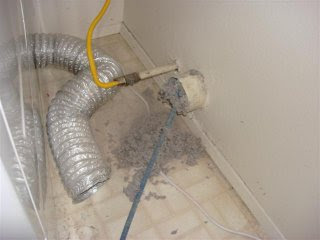Stop, Drop and Clean out your dryer hose
We have been having trouble with our dryer working properly. Our clothes were still damp after the dryer cycle. It is only three years old, so I wasn't expecting any problems. Our appliance repair man was out to do a checkup on our washer, so I asked him about the dryer. He suggested that we clean out the dryer hose that is connected to the back of our dryer. So Greg and I took a few minutes to do so. I cannot tell you how much lint and other disgusting things had built up in that hose. (the picture to the left isn't our dryer. This one is "clean" compared to ours!) It filled our vacuum cleaner bag (that I had just changed). Can you say "fire hazard". I'm careful to always clean the lint trap so it was hard to believe that much lint had built up in the hose after only three years.
If your dryer is taking longer than normal to dry your clothes, a buildup of lint may be the problem. Even if your dryer seems to be working just fine and its been a few years since you did this process, take a few minutes, pull out your dryer, use the wand attachment and clean the floor and wall behind the dryer and the back of the dryer itself. Then remove the hose from both the wall and the dryer. Take it outside and shake it into a garbage bag. Greg made the mistake of dumping all the lint on the floor of the laundry room. He got some angry eyes. Use the wand attachment and clean out any lint that you can see inside the wall and just inside the dryer. If needed, a chimney sweep can also help get any that is in the wall you cannot reach.
Not only will this help save you time and money, it may save your life.
The U.S. Consumer Product Safety Commission estimates that in 1998, clothes dryers were associated with 15,600 fires, which resulted in 20 deaths and 370 injuries. Fires can occur when lint builds up in the dryer or in the exhaust duct. Lint can block the flow of air, cause excessive heat build-up, and result in a fire in some dryers.
This is from the CPC website to help prevent fires:
Clean the lint screen/filter before or after drying each load of clothes. If clothing is still damp at the end of a typical drying cycle or drying requires longer times than normal, this may be a sign that the lint screen or the exhaust duct is blocked.
Clean the dryer vent and exhaust duct periodically. Check the outside dryer vent while the dryer is operating to make sure exhaust air is escaping. If it is not, the vent or the exhaust duct may be blocked. To remove a blockage in the exhaust path, it may be necessary to disconnect the exhaust duct from the dryer. Remember to reconnect the ducting to the dryer and outside vent before using the dryer again.
Clean behind the dryer, where lint can build up. Have a qualified service person clean the interior of the dryer chassis periodically to minimize the amount of lint accumulation. Keep the area around the dryer clean and free of clutter.
Replace plastic or foil, accordion-type ducting material with rigid or corrugated semi-rigid metal duct. Most manufacturers specify the use of a rigid or corrugated semi-rigid metal duct, which provides maximum airflow. The flexible plastic or foil type duct can more easily trap lint and is more susceptible to kinks or crushing, which can greatly reduce the airflow.
Take special care when drying clothes that have been soiled with volatile chemicals such as gasoline, cooking oils, cleaning agents, or finishing oils and stains. If possible, wash the clothing more than once to minimize the amount of volatile chemicals on the clothes and, preferably, hang the clothes to dry. If using a dryer, use the lowest heat setting and a drying cycle that has a cool-down period at the end of the cycle. To prevent clothes from igniting after drying, do not leave the dried clothes in the dryer or piled in a laundry basket.

If your dryer is taking longer than normal to dry your clothes, a buildup of lint may be the problem. Even if your dryer seems to be working just fine and its been a few years since you did this process, take a few minutes, pull out your dryer, use the wand attachment and clean the floor and wall behind the dryer and the back of the dryer itself. Then remove the hose from both the wall and the dryer. Take it outside and shake it into a garbage bag. Greg made the mistake of dumping all the lint on the floor of the laundry room. He got some angry eyes. Use the wand attachment and clean out any lint that you can see inside the wall and just inside the dryer. If needed, a chimney sweep can also help get any that is in the wall you cannot reach.
Not only will this help save you time and money, it may save your life.
The U.S. Consumer Product Safety Commission estimates that in 1998, clothes dryers were associated with 15,600 fires, which resulted in 20 deaths and 370 injuries. Fires can occur when lint builds up in the dryer or in the exhaust duct. Lint can block the flow of air, cause excessive heat build-up, and result in a fire in some dryers.
This is from the CPC website to help prevent fires:
Clean the lint screen/filter before or after drying each load of clothes. If clothing is still damp at the end of a typical drying cycle or drying requires longer times than normal, this may be a sign that the lint screen or the exhaust duct is blocked.
Clean the dryer vent and exhaust duct periodically. Check the outside dryer vent while the dryer is operating to make sure exhaust air is escaping. If it is not, the vent or the exhaust duct may be blocked. To remove a blockage in the exhaust path, it may be necessary to disconnect the exhaust duct from the dryer. Remember to reconnect the ducting to the dryer and outside vent before using the dryer again.
Clean behind the dryer, where lint can build up. Have a qualified service person clean the interior of the dryer chassis periodically to minimize the amount of lint accumulation. Keep the area around the dryer clean and free of clutter.
Replace plastic or foil, accordion-type ducting material with rigid or corrugated semi-rigid metal duct. Most manufacturers specify the use of a rigid or corrugated semi-rigid metal duct, which provides maximum airflow. The flexible plastic or foil type duct can more easily trap lint and is more susceptible to kinks or crushing, which can greatly reduce the airflow.
Take special care when drying clothes that have been soiled with volatile chemicals such as gasoline, cooking oils, cleaning agents, or finishing oils and stains. If possible, wash the clothing more than once to minimize the amount of volatile chemicals on the clothes and, preferably, hang the clothes to dry. If using a dryer, use the lowest heat setting and a drying cycle that has a cool-down period at the end of the cycle. To prevent clothes from igniting after drying, do not leave the dried clothes in the dryer or piled in a laundry basket.



Comments